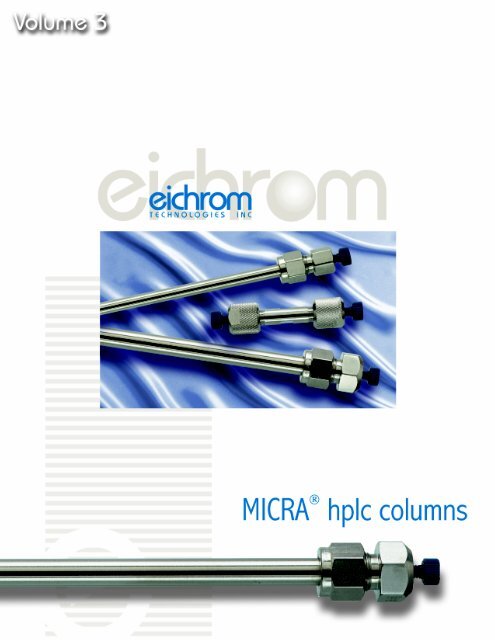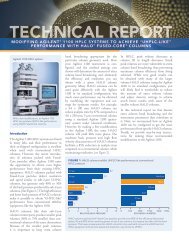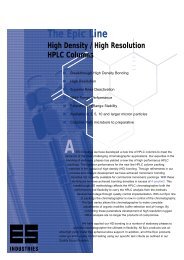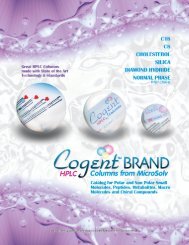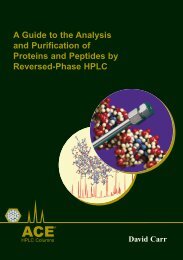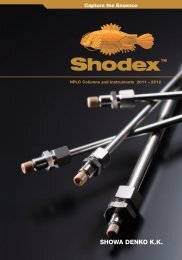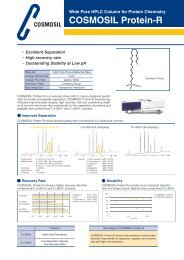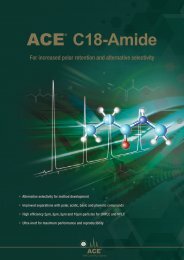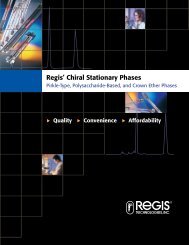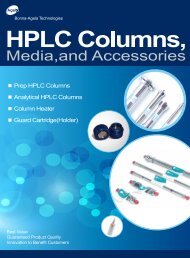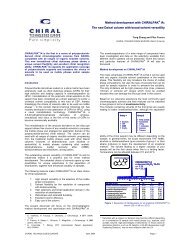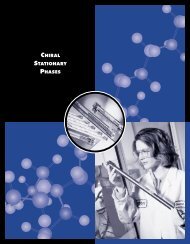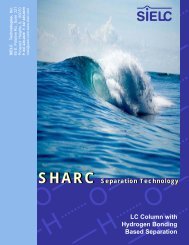You also want an ePaper? Increase the reach of your titles
YUMPU automatically turns print PDFs into web optimized ePapers that Google loves.
2EICHROM TECHNOLOGIES, INC.<strong>MICRA</strong> ® <strong>HPLC</strong> <strong>Columns</strong>“Creating Knowledge From Science”ORDER INFORMATION:In the United States contact:In Europe contact:Eichrom Technologies, Inc.Eichrom Europe SARL.8205 S. Cass Ave. Suite 111 50 rue de ParadisDarien, IL. U.S. 6056175010 Paris - FRANCEPhone: 630-963-0320 Phone: +33 (0) 1 53 34 17 24FAX: 630-963-1928 FAX: +33 (0) 1 47 70 36 88Toll free: 800-422-6693EichromEurope@eichrom.cominfo@eichrom.comFor other international inquires contact:Eichrom’s U.S. office or the web site. (All Eichrom international distributors are listed.)WWW.EICHROM.COMVisit www.eichrom.com for information on all Eichrom products. The site includes product descriptions,part numbers, applications, and e-commerce. Technical questions or literature requests can be sent viaemail to: info@eichrom.com.TECHNICAL ASSISTANCECall us for all of your application needs at 800-556-4272. We offer assistance in the area of <strong>HPLC</strong> methodsdevelopment or any type of <strong>HPLC</strong> analysis as well as general information on specific applications.Eichrom’s technical assistance group also offers customer sample submissions to help determine the bestcolumn to use for your specific assay needs.WARRANTYThe entire <strong>MICRA</strong>-<strong>HPLC</strong> column line, manufactured by Eichrom, is warranted to be free from defects inmaterial and workmanship for 30 days from date of receipt. All columns are individually tested and packagedwith a quality assurance chromatogram.RETURNSProduct returns will not be accepted without prior authorization. There is a 15% restocking charge forreturned items.LIABILITYEichrom’s products are intended for laboratory use only, not as drugs, food, or for household usage. Theseproducts must be handled with due care and only by professional laboratory staff.LITERATUREApplication notes, chromatograms, technical notes, poster reprints, literature reprints and a referencebibliography for both porous and non-porous phases are available upon request.
3Table of ContentsWho is Eichrom? .................................................................................................................. 4Column Selection guide for <strong>MICRA</strong> ® -<strong>HPLC</strong> supports ................................................................ 5Benefits Guide for <strong>MICRA</strong>-Platinum, <strong>MICRA</strong>-Gold, and <strong>MICRA</strong> Silver ......................................... 6-7<strong>MICRA</strong>-Platinum Reversed Phase <strong>HPLC</strong> <strong>Columns</strong>Featured advantages of <strong>MICRA</strong>-Platinum NPS ® non-porous silica ............................................ 8-9NPS ODS-I .......................................................................................................................... 10-11ODS-II ........................................................................................................................ 12ODS-IIIE ..................................................................................................................... 13ODS-TAS and NPS-Sil ................................................................................................... 14NPS Information and Operating Instructions .......................................................................... 15Applications in LC/MS ...........................................................................................................16Applications in Proteomics .................................................................................................... 17<strong>MICRA</strong>-Platinum RP-MS ........................................................................................................ 18<strong>MICRA</strong>-Platinum SCD-MS ...................................................................................................... 19<strong>MICRA</strong>-Gold <strong>HPLC</strong> <strong>Columns</strong>Reversed Phase ................................................................................................................... 20-21Reversed Phase SCD Specialty Support .................................................................................. 22Cation Exchange .................................................................................................................. 23Anion Exchange ................................................................................................................... 24-25Size Exclusion (GPC)............................................................................................................. 26-27Size Exclusion Cationic-Polymer (CATSEC) .............................................................................. 28-29Size Exclusion GPC PEP and GPC LINEAR ............................................................................... 30<strong>MICRA</strong>-Silver <strong>HPLC</strong> <strong>Columns</strong>Hydrophobic Interaction (HIC) .............................................................................................. 31Reversed Phase ................................................................................................................... 32-33Anion Exchange ................................................................................................................... 34-35Cation Exchange .................................................................................................................. 36-37Column Usage Guidelines...................................................................................................... 38-39
4Who is Eichrom?Eichrom Technologies, Inc. is a world leader in separation chemistry and brings diversity to the<strong>HPLC</strong> marketplace with its recent introduction of <strong>MICRA</strong> ® -Platinum, <strong>MICRA</strong> ® -Gold, and<strong>MICRA</strong> ® -Silver <strong>HPLC</strong> columns. This introduction is made possible by the 1998 acquisition of theworld-renowned SynChropak ® bonding chemistry and the revolutionary NPS ® non-poroussilica particle technology. Eichrom’s leadership in the separations industry began with breakthrough technologiesdeveloped at Argonne National Laboratory for radioactive isotopes. Eichrom’s founding, on Feb. 7, 1990,brought the commercialization of products which deliver efficient separations and pre-concentration of radionuclidesfrom environmental and bioassay samples. Further innovative research in particle manufacturing andimmunoassay has resulted in significant company developments and products for the food safety industry aswell as in areas of clinical diagnostics, and cell separation.<strong>HPLC</strong> Markets Served<strong>HPLC</strong> products are manufactured to meet the application needs in the areas of life science/proteomics, pharmaceuticals,cosmetics, and environmental separations. Offices in both the U.S. and Europe as well as aworldwide network of international distributors supports an international customer base.Chromatographic Techniques/Product offering<strong>HPLC</strong> (High Performance Liquid Chromatography) and LC-MS (Liquid Chromatography-Mass Spectrometry)products are offered for Reversed Phase, Anion and Cation Exchange (Both weak and strong), Size Exclusion(GPC), and Hydrophobic Interaction.Eichrom’s <strong>MICRA</strong> ® -Platinum, <strong>MICRA</strong> ® -Gold, and <strong>MICRA</strong> ® -Silver are manufactured to meet the demand forexceptional performance in analytical applications. All porous phases are based on SynChropak bonding chemistry,known for over two decades of excellent resolution, stability, and reproducibility.The NPS ® particles arederived from a patented, “metal free” manufacturing process. The spherical non-porous silica is 1.5µ, verypure, highly uniform, and brings advantages to the <strong>HPLC</strong> marketplace which complement standard poroussupports.Column Performance Options<strong>MICRA</strong> ® -Platinum <strong>Columns</strong>• Reversed Phase and Normal Phase• 1.5µ non-porous silica/3µ porous silica• High throughput/LC-MS applications• Three C-18 bonded phases for NPS• NPS ® TAS offers extra resolving power• C18 and SCD (Short Chain, Base Deactivated) for porous silica<strong>MICRA</strong> ® -Gold <strong>Columns</strong>• Reversed Phase - Ion Exchange - Size Exclusion• 5µ, 7µ, 10µ Spherical Silica• 100, 300, 500, 1000, 4000 Å Pore Sizes• Unique to the industry:• “SCD100” for drug applications• “CATSEC” for cationic polymers<strong>MICRA</strong> ® -Silver• Reversed Phase - Ion Exchange - Hydrophobic Interaction• 6µ, 300 Å, Spheroidal Silica• Economical Benefits for Methods Development• Well Suited for Preparative Formatsw w w . e i c h r o m . c o m
5Guide to Eichrom Technologies <strong>MICRA</strong>-<strong>HPLC</strong> SupportsParticle Pore Phase Phase MW Specific USP<strong>MICRA</strong>-Line size (µ) size (A) Description Characteristics Range Application XXIISILVER RPRP4 300 6 300 C4 polymeric >1000 peptides/proteins L26RP8 300 6 300 C8 monomeric >1000 peptides/proteins L7RPP300 6 300 C18 monomeric >1000 peptides L1SILVER Ion Ex.AX 300 6 300 WAX polyethyleneimine 1000 large proteins/biopolymers L26RP8 HC 5 300 C8 monomeric >1000 peptide mapping/protein digests L7RP8 1000 7 1000 C8 monomeric >1000 proteins L7RPP 100 5 100 C18 monomeric e/c 1000 peptides/proteins L1RPP 4000 10 4000 C18 monomeric >1000 peptides/proteins L1SCD 100 5 100 Proprietary base deactivated e/c
6<strong>MICRA</strong>-Platinum columns represent the state-of-the-art in column chromatography. Thisperformance category includes column supports containing the NPS ® non-porous silica particletechnology available in a 1.5µ size, as well as 3µ porous column supports derived from theSynChropak ® bonding chemistry. These columns are designed for the analysis and purificationof peptides/proteins, basic/acidic molecules, and pharmaceutical compounds by high throughput analysis or LC-MS techniques. This line of columns provides exceptional performance in speed of analysis, sensitivity, stability/reproducibility and low sample/solvent waste. NPS ® is a very pure silica, utilizing the <strong>MICRA</strong> patented, metalfree manufacturing procedure.Three NPS ® C18 bonding chemistries are offered to meet selectivity needs:• ODS-I, a polymeric C18, offers the larger operating pH range and high column stability.• ODS-II, a monomeric C18, provides a less hydrophobic surface (due to exposed surface silanols) forimproved selectivity of polar and neutral analytes.• ODS-IIIE, an endcapped, monomeric C18, is designed for analysis of basic compounds and pharmaceuticals.Three NPS ® specialty columns include:• NPS ® TAS, a C30 extended chain length is suited for caratenoid analysis and fat soluble vitamins.• NPS ® PAH, offers excellent resolution of the 16 priority pollutants in less than 8 minutes.• NPS ® SIL, is well suited for normal phase analysis and LC-MS applications.Porous supports for high throughput and LC-MS applications:• 3µ RP-MS is a highly hydrophobic C18, 100Å endcapped phase designed for small molecules, aminoacids, and nucleotides.• 3µ SCD-MS is a base deactivated phase designed for pharmaceutical analysis.<strong>MICRA</strong>-Gold columns are Eichrom’s standard line of porous <strong>HPLC</strong> columns. They are based on SynChropakbonding chemistry and designed for the analysis and purification of proteins, peptides, polymers, basic/acidicmolecules, and pharmaceuticals.Reversed PhaseRP4 is optimal for the loading and high resolution of peptides and yields excellent recovery for proteins. RP-P,known for greater resolution and superior selectivity, is commonly used for the separation of smaller peptides,low hydrophobicity proteins, nucleotides, and amino acids. The very hydrophobic RP-P100 and the less hydrophobicSCD100 (base-deactivated) offer a combination which effectively resolves drug mixtures.Ion exchangeThese supports offer excellent selectivity based on ionic properties of a solute. They are appropriate for separatingclosely related organic acids, nucleotides ranging from mono to triphosphates and proteins which differ byonly one or two amino acids.Size ExclusionThe GPC series contains products with 7 pore diameters (50Å-4000 Å) allowing analysis of solutes with molecularweights ranging from 0.5kDa to 10,000kDa. The glycerol bonded phase is designed for the rapid analysis ofproteins, carbohydrates, nucleic acids, and other water soluble anionic or neutral polymers. The <strong>MICRA</strong>-GoldCATSEC series, exclusive to Eichrom Technologies, is a polymerized polyamine support available in four diameters(100Å -4000Å) allowing the analysis of cationic polymers such as polyvinylpyridines to elute according to size andwithout adsorption.The <strong>MICRA</strong>-Silver series offers economical benefits to method development and preparative work. It is wellsuited for dedicating columns to specific analyses and scaling up from analytical to preparative applications. RP-4is a polymeric bonding with a C4 ligand chain and is a popular choice for protein/peptide separations, particularlylarge hydrophobic solutes. RP-8 and RP-P are monomeric bondings and are appropriate for separating smallerproteins/peptides with a less hydrophobic nature. Both weak and strong Anion and Cation exchange supports areavailable for separating ionic compounds. They are compatible with aqueous buffers and many organic solventsin the pH 2-8 range. Hydrophobic Interaction Chromatography (HIC), uses descending salt gradients for elution,preserving the tertiary structure of the proteins and their enzymatic activity.
7• 1.5µ and 3µ highly spherical and uniform,• porous and NPS non-porous silica.• Short run times, low solvent consumption• High sensitivity• Available phases includeNPS (non-porous):Reversed phase: ODS-I, ODS-II, ODS-IIIE, TAS, PAHNormal phase: SILPorous:Reversed phase: RP-MS, SCD-MS• Highly spherical silica of very uniform size• Particle sizes 5, 7 & 10µ• Pore sizes 50Å ,100Å, 300Å, 500Å, 1000Å, 4000Å• Phases available include:Reversed phase: RP4 (300, 1000, 4000)RP8 (300, 1000) RP-P 100,RPP (100, 1000, 4000), SCD100Anion Exchange: AX (100, 1000), Q100Cation Exchange: CM100, S1000Size Exclusion: GPC PEP, GPC LinearGPC (100, 300, 500, 1000, 4000)CATSEC (100, 300, 1000, 4000)• 6µ, 300Å, Spheroidal silica• Column sizes: 2-10mm ID & 50-300mm length• Phases available include:Reversed phase: RP4, RP8, RPP (RP18)Anion exchange: AX300, Q300Cation exchange: CM300, S300Hydrophobic Interaction: HIC-Propyl8 0 0 . 4 2 2 . 6 6 9 3
8<strong>MICRA</strong>-Platinum Reversed Phase <strong>HPLC</strong> columns<strong>MICRA</strong> ® NPS ® 1.5µ non-porous silicaFAST CHROMATOGRAPHY AND RESOLUTIONThe goal of fast chromatography is to reduce analysis time while still maintaining good resolution. Severalways to improve speed are possible, the most widely used means have centered on using shorter columnspacked with smaller particles and increasing flow rate. These methods do not alter the selectivity nor theretention factor (k) of the components, the analyte resolution will change only with changes in columnefficiency (N), directly linked to the column length (L) and particle size (d p) by the equations (H = L/N) and(N ∝ 1/d p). The ideal case for fast chromatography is to use short columns packed with small particles tomaximize speed while maintaining column efficiency. Column efficiency, however, can be further enhanced byminimizing mass transfer effects associated with the support material. The use of nonporous particles eliminatesthe pore diffusion (B & C) terms of the van Deemter equation (H = A + B/u + Cu). As shown in thevan Deemter plots below, columns packed with 1.5µ NPS particles exhibit very high efficiencies that areinsensitive to changes in flow rate or linear velocity (u). <strong>MICRA</strong> NPS represents the ideal <strong>HPLC</strong> columnsupport for fast separations at the highest resolution possible.RETENTION FACTOR AND SPEEDEliminating pores also reduces the available surface area for C-18 bonding. For a given diameter of highlyuniform nonporous silica particles, the surface area available for bonding is calculated from the density andparticle diameter of the silica. For NPS we typically measure a density of 2.1 ± 0.1 g/mL and for a 1.5µ NPSmaterial the surface area then is 1.9 m 2 /g (a typical porous support surface area of around 200 m 2 /g and asilica density of 0.4 g/mL).In reversed phase separations, the equation below can be used to compare the expected values of k for thetwo supports : k = KV s/V mThe distribution coefficient (K), the support volume (V s) and the mobile phase concentration (V m) contributeto the distribution of solute between the stationary surface and moving liquid. The pores themselves do notchange the solute-solvent equilibrium to any significant degree. The surface area of the support is, therefore,very representative of the support contribution to the equilibrium of the column. Eliminating the porosityeliminates 50% of the available liquid volume (V m) in a packed column (V m,NPS≈ 1/2 V m,porous).NPS has 5 times the density and 1/100 the surface area of porous supports. For the same separation andmobile phase composition, NPS will exhibit capacity factors, k, roughly 10 times smaller compared to atypical porous silica.w w w . e i c h r o m . c o m
<strong>MICRA</strong>-Platinum Reversed Phase <strong>HPLC</strong> columns<strong>MICRA</strong> ® NPS ® 1.5µ non-porous silica9Illustrations show advantages of using columns packed with non-porous silica overcolumns packed with the more traditional porous silica.FasterHigh SensitivityStability Improved8 0 0 . 4 2 2 . 6 6 9 3
10<strong>MICRA</strong>-Platinum Reversed Phase <strong>HPLC</strong> columnsNPS ODS-IThe 1.5µ NPS ODS-I is a premium support ofchoice for most separations. It offers an excellentcombination of stability, versatility, efficiency andshape selectivity for a broad range of separations.This is a polymeric bonding and yields low surfacesilanol activity, without endcapping. ODS-I offersfast and efficient separation opportunities in theareas of pharmaceutical, life science, and environmental.PharmaceuticalWith the addition of less organic modifier than onconventional porous columns, it is possible toseparate basic compounds as is shown in theanalysis of Barbiturates. Most USP methods canbe modified to use up to 90% less organic andobtain up to 20 times faster separations. Thistranslates to most drug types including analgesics,β -blockers, antidepressants, vitamins, coughand cold, hormones, antibiotics, derivatives, andsedatives.EnvironmentalODS-I PAH specialty column demonstrates areproducible and rugged method for the separationof 16 PAHs in less than 8 minutes. The U.S.EPA classifies the compounds as priority pollutantsrequiring routine monitoring for regulatoryadministration in drinking water, waste water andsoil using methods 610, SW-846, and 8310.ChiralEnantiomeric separations using a chiral eluentselector yields fast results with good resolution.Chiral SeparationLife ScienceRapid analysis in the area of life science is illustratedwith the separation of molecules such asamino acids, peptides, proteins and tryptic digest.See pages 16-17 for LCMS applications as well asa fast alternative to the time consuming and laborintensive method to measure and quantify proteinexpression in cells, 2-D polyacrylamide gel electrophoresis.ORDERING INFORMATION<strong>MICRA</strong>-Platinum 1.5µ NPS silica ODS-I ODS-I PAH ODS-I CYD(PAH Certified) (Chiral Mobile Phase Selector)Format (mm) Item Number Item Number Item NumberMini-bore 33x3 0430ODS101.553x30630ODS101.5Fast Analysis 14x4.6 0146ODS101.5Standard 33x4.6 0446ODS101.5 0446PAH101.5 0446CYD101.5High Capacity 53x4.6 0646ODS101.5w w w . e i c h r o m . c o m
<strong>MICRA</strong>-Platinum Reversed Phase <strong>HPLC</strong> columns11NPS ODS-ISuggested and available Pharmaceutical, Life science, and Environmental applications for <strong>MICRA</strong> Platinum NPSODS-I supports include amino acids, analgesics, antibiotics, barbiturates, benzodiazepines, benzotriazole, β -blocking drugs, capillary formats, catecholamines, epirubicin, explosives, food additives, mini-bore formats, onlineprocess monitoring, polynuclear aromatic hydrocarbons, preservatives, steroids, sun screens, tricyclicantidepressants, and water soluble vitamins.BarbituratesTryptic Digest of HemoglobinAmino Acidstime (min)Protein MixturePAH EPA 610 standardtime (min)8 0 0 . 4 2 2 . 6 6 9 3
12<strong>MICRA</strong>-Platinum Reversed Phase <strong>HPLC</strong> columnsNPS ODS-IIODS-II is monomerically bonded and offers a more hydrophilic surface than the ODS-I phase but less stabilitydue to decreased shielding of the surface silanols. The increase in silanophilic interactions with analytes andmobile phases provides an opportunity to alter selectivity and resolve components that otherwise do not separateon the more shielded ODS-I, polymerically bonded, phase. As the ODS-II applications demonstrate, fastseparations with high efficiency are obtained with this column technology. The detection of 103 peaks in thetryptic digest of apotransferrin, illustrated below, highlights the excellent resolution and high peak capacitypossible with this column.Artificial SweetnersTransferrin Digesttime (min)Sunscreenstime (min)Phthalate AnalysisORDERING INFORMATION<strong>MICRA</strong>-Platinum 1.5µ NPS silica ODS-IIFormat (mm) Item NumberFast Analysis 14x4.6 0146ODS201.5time (min)Standard 33x4.6 0446ODS201.5High Capacity 53x4.6 0646ODS201.5w w w . e i c h r o m . c o m
<strong>MICRA</strong>-Platinum Reversed Phase <strong>HPLC</strong> columns13NPS ODS-IIIEODS-IIIE is an endcapped, monomeric bonding. It is specifically designed for fast analysis and excellent resolutionof basic compounds. The most critical factors in this type of analysis are peak shape and column stability.These key factors are illustrated below as well as an example of the opportunities ODS-IIIE offers for rapidprotein profiling.AntihistaminesAntiarrhythmicstime (min)Protein Profilingtime (min)ORDERING INFORMATION<strong>MICRA</strong>-Platinum 1.5µ NPS silica ODS-III EFormat (mm) Item NumberFast Analysis 14x4.6 0146ODS3E1.5Standard 33x4.6 0446ODS3E1.5High Capacity 53x4.6 0646ODS3E1.58 0 0 . 4 2 2 . 6 6 9 3
14<strong>MICRA</strong>-Platinum <strong>HPLC</strong> columnsNPS ODS-TAS:C30NPS-TAS is an extended C30 chain length with high carbon load for higher resolving power. It is designed forrapid analysis of carotenoids and fast separation of oil soluble vitamins as well as 2,4-DNPH and other DNPHaldehydesand ketones in air samples. For information is available on this applications by requesting applicationnotes AP20 an AP22.CarotenoidsDNPH Aldehydestime (min)NPS-Sil : normal phase<strong>MICRA</strong>-Platinum Sil is a non-bonded phase on 1.5 nonporousspherical silica. NPS columns offer increasedstability, short run times, high sensitivity, and greatlyimproved mass transfer. This column is excellent for highthroughput and QC lab applications, as well as LC/MSseparations. They are highly efficient for all normal phaseapplications and work particularly well with very polarcompounds.Vitamins A and DORDERING INFORMATION<strong>MICRA</strong>-Platinum ODS-TAS ODS-Sil1.5µ NPS silicaFormat (mm) Item Number Item NumberStandard 33x4.6 0446TAS101.5 0446NPS01.5High Capacity 53x4.6 0646TAS101.5w w w . e i c h r o m . c o m
<strong>MICRA</strong>-Platinum NPS 1.5µ <strong>HPLC</strong> <strong>Columns</strong>Information & Operating Instructions For Optimum Results15Silica Surface Bonded Phase DescriptionsODS-I, II and IIIE have similar surface C-18 ligand densities. ODS-I is more stable in low and high pH environmentsdue to increased surface shielding provided by the polymeric surface chemistry. The ODS-II is a monomericC18 silane resulting in a more accessible silica surface making it more hydrophilic in nature with improved selectivitybetween closely related polar components. ODS-IIIE is an endcapped version of ODS-II . It provides excellentpeak shape and is well suited for basic drug and pharmaceutical analysis. 100% aqueous mobile phases can beused with all of these phases. The 33x4.6 mm columns yield an approximate plate efficiency of 5000 plates/column on standard LC systems. Column loading capacities is 5000ng/column. For optimum efficiencies, useinjection volumes of 2µl.Particle Size ConsiderationsEichrom’s 1.5µ NPS columns offer increased speed of analysis, increased resolution of small samples, decreasedsolvent consumption, and equilibration time savings for routine analytical work. These columns are compatiblewith conventional equipment, however, a t 0of
16<strong>MICRA</strong>-Platinum Reversed Phase <strong>HPLC</strong> columnsApplications in LC/MS<strong>MICRA</strong> NPS technology provides the opportunity for a new TOF-based LC-MS system which rapidly resolvesand identifies all of the individual components present while maintaining high peak capacity. As shown below,Analytica of Brandford’s MS-Enterprise can analyze complex mixtures in well under 1 minute with elution timeas narrow as 300 ms as shown below. Fast LC-ESI/MS analysis of herbicides using NPS ODS-I has been developedby American Cyanamid CO., Princeton, NJ. For additional information on these procedures, requestapplication notes and AP14, AP21, and/or reference the article: Rapid Peptide Mapping by RP-LC on NonPorous Silica with On-Line Electrospray Time-of-Flight Mass Spectrometry, Banks J. F. and GulciekE., Anal. Chem., 69, (19), 3973-8, (1997).Fast LC separation of peptidesMass Spectra of the Individual peptidesLCMS-HerbicidesLCMS-Tryptic Digesttime (min)w w w . e i c h r o m . c o m
<strong>MICRA</strong>-Platinum Reversed Phase <strong>HPLC</strong> columns17Applications in Proteomics :A novel 2D liquid phase separation method for protein mappingThe time consuming and labor intensive method to measure and quantify protein expression in cells, 2-D polyacrylamidegel electrophoresis (PAGE), is now replaceable by a novel method using NPS technology. (For additionalinformation, request application note: AP34).The alternative to 2-D PAGE involves a first step of separating proteins from the human erythroleukemia (HEL)cell line by pI using Rotofor (Biorad) Isoelectric Focusing (IEF) (horizontal axis) followed by a gradient <strong>HPLC</strong>separation based on hydrophobicity (vertical axis) using <strong>MICRA</strong>-Platinum NPS ODS-I. This digital image, shownbelow, is obtained from the UV (214 nm) chromatographic output converted to an ASCII format using a 256 stepgray scale. This method of presenting the data is designed to offer the same advantages of pattern recognitionand protein profiling obtained using 2-D PAGE. The entire procedure is outlined in Isoelectric Focusing NonporousRP <strong>HPLC</strong> : A Two-Dimensional Liquid-Phase Separation Method for Mapping of CellularProteins with Identification Using MALDI-TOF Mass Spectrometry, Wall, D.B., et.al, Anal. Chem., 72, (6),1099-1111, (2000). A copy of this article and several others on protein mapping is available from Eichrom uponrequest.Protein mapping has also been performed by classical 2D-<strong>HPLC</strong> using cation or anion exchange columns in thefirst dimension and NPS columns in the second dimension. This system offers high-resolution protein separationwith a total analysis time of less than 20 min, equivalent to the run time of the first dimension. Ref.: Proteinmapping by two-dimensional <strong>HPLC</strong>, Wagner K., Racaityte K., Unger K. K., Miliotis T., Edholm L. E., Bischoff R.and Marko-Varga, J. Chromatogr. A,893, 293-305, (2000)NPS advantages over PAGEAnalysis timesHours vs. DaysEliminates labor intensive aspects of PAGEWorks well with whole cell lysatesMS InterfaceReadily automated with sample collectorsProteins isolated in liquid phaseLow chemical background noiseHigh protein recoveryMinimal non-specific adsorption using NPSHigh loadability for protein isolation, purification or sequencingSuperior sensitivity for low MW proteins8 0 0 . 4 2 2 . 6 6 9 3
18<strong>MICRA</strong>-Platinum Reversed Phase <strong>HPLC</strong> columns3µ, 100Å, porous silica: C18, RP-MS phaseRP-MS is a C18 endcapped, 3 micron support designed for high throughput analysis and LC/MS applications.Typical mixtures of small molecules are resolved such as amino acids, peptides, nucleotides and watersolublevitamins. Examples below include a fast isocratic separation of β-blocking drugs performed on a50x2.1mm column and an analysis of parabens is done in less than 4.5 min with the same size column.Application notes on these samples are available by requesting AP29 and AP30 respectively. Additionalapplication notes using <strong>MICRA</strong>-Platinum RP-MS include AP30 for analgesics and anti-inflammatory compoundsas well as AP32 for tricyclic antidepressants (TCA), and diazepams.Beta-Blocking DrugsParabensORDERING INFORMATION<strong>MICRA</strong>-Platinum RP-MS 100 A , 3µFormat Item Number(mm)LC-MS 50x2.1 MB2CR101-3-5Standard 100x4.6 CR101-3-10150x4.6 CR101-3-15Standard Guard 50x4.6 FCR101-3-5Guard cartridges 3/pkg 10x3.2 KR101-1Stainless Steel Guard holderKART-Gw w w . e i c h r o m . c o m
<strong>MICRA</strong>-Platinum Reversed Phase <strong>HPLC</strong> columns193µ, 100Å, porous silica: short chain base-deactivated, SCD-MS phaseSCD-MS is a short chain base-deactivated support designed for drug mixtures. These columns combine theunique selectivity of the SynChropak SCD-100 bonded phase with 3 particles, in a small column format idealfor fast MS applications. The SCD unique base deactivation produces excellent peak shape for drugs with high“pK a”s. The lower level of hydrophobicity decreases the amount of organic modifier needed.AnalgesicsDiazepinestime (min)TCA analysisORDERING INFORMATION<strong>MICRA</strong>-Platinum SCD-MS 100 A , 3µFormat Item Number(mm)LC-MS 50x2.1 MB2SCD100-3-5Standard 50x4.6 SCD100-3-5100x4.6 CSCD100-3-10150x4.6 CSCD100-3-15Standard Guard 50x4.6 FSCD100-3-5time (min)Guard cartridges 3/pkg 10x3.2 KSCD100-1Stainless Steel Guard holderKART-G8 0 0 . 4 2 2 . 6 6 9 3
20<strong>MICRA</strong>-Gold Reversed Phase <strong>HPLC</strong> <strong>Columns</strong>C4 BondingThe polymerically bonded, non-endcapped, C4supports are a popular choice for protein andpeptide separations, especially for large hydrophobicsolutes. C4 ligands are often used withprotein separationss due to their excellentrecovery.<strong>MICRA</strong>-Gold RP45µ, 300Å, Spherical silicaThis 300Å pore size is optimal for the loadingand high resolution of peptides.<strong>MICRA</strong>-Gold RP4 10007µ , 1000Å, Spherical silicaDecreased surface area of RP4 supports resultsin faster analysis and increased recovery ofsmall samples.<strong>MICRA</strong>-Gold RP4 400010µ , 4000Å, Spherical silicaThis 4000Å support is especially popular forvery large hydrophobic solutes. It delivers highspeed analysis and excellent sample recovery.C8 Bonding<strong>MICRA</strong>-Gold RP8 10007µ , 1000Å, Spherical silicaThe monomerically bonded C8 support is suitedfor separating smaller proteins and peptides,especially those of a less hydrophobicnature.The decreased surface area of this nonendcapped,1000Å, support results in fasteranalysis and increased recovery of smallsamples.C18 BondingThe monomerically bonded C18 supports offerhigh retention and superior selectivity.<strong>MICRA</strong>-Gold RPP 1005µ, 100Å, Spherical silicaThis 100Å support is endcapped and offersexcellent results for the separation of aminoacids, small peptides, nucleotides, and othersmall molecules such as water-soluble vitamins.(See page 22 for part numbers)<strong>MICRA</strong>-Gold RPP 10007µ , 1000Å, Spherical silicaThis 1000Å support is ideal for the separationof small peptides, nucleotides, and amino acids.Decreased surface area results in faster analysisand increased recovery of small samples.<strong>MICRA</strong>-Gold RPP 400010∝ , 4000Å, Spherical silicaRPP 4000, similar to RPP 1000 in separationresults, offers higher speed and compatabilitywith larger hydrophobic solutes.ORDERING INFORMATION<strong>MICRA</strong>-Gold Reversed Phase <strong>HPLC</strong> <strong>Columns</strong>RP4 300 RP4 1000 RP4 4000 RP8 1000 RPP 1000 RPP 4000300 A , 5µ 1000 A, 7µ 4000 A , 10µ 1000 A , 7µ 1000 A , 7µ 4000 A , 10µFormat (mm) Item Number Item Number Item Number Item Number Item Number Item NumberNarrow-bore 100x2.1 MB2C4RG103-10 MB2C4R110-10 MB2C4R140-10 MB2C8R110-10 MB2CR110-10 MB2CR140-10250x2.1 MB2C4RG103-25 MB2C8R110-25 MB2CR110-25 MB2CR140-25Narrow-bore Guard 50x2.1 MB2FC4RG103-5 MB2FC4R110-5 MB2FC4R140-5 MB2FC8R110-5 MB2FCR110-5 MB2FCR140-5Standard 50x4.6 C4R110-5 C4R140-5100x4.6 C4RG103-10 C4R110-10 C4R140-10 C8R110-10 CR110-10 CR140-10250x4.6 C4RG103-25 C4R110-25 C4R140-25 C8R110-25 CR110-25 CR140-25Standard Guard 50x4.6 FC4RG103-5 FC4R110-5 FC4R140-5 FC8R110-5 FCR110-5 FCR140-5Guard cartridges 3/pkg 10x3.2 K4RG103-1 K4R110-1 K4R140-1 K8R110-1 KR110-1 KR140-1Stainless Steel Guard holder KART-G KART-G KART-G KART-G KART-G KART-GFor information on Reversed Phase Peptide Standards, see page 32.w w w . e i c h r o m . c o m
<strong>MICRA</strong>-Gold Reversed Phase <strong>Columns</strong> exhibit high stability and excellentresolution. Suggested applications include amino acids, nucleotides, peptides,and proteins.21Protein DigestsPore size Optimum MW Surface area100Å
22<strong>MICRA</strong>-Gold Specialty Reversed Phase <strong>HPLC</strong> Column<strong>MICRA</strong>-Gold SCD5µ , 100Å, Spherical silicaThis uniquely deactivated reversed phase support is bonded with a short alkyl chain ligand and is endcapped.Excellent peak shapes are obtained for many drug mixtures without the addition of silanol suppressing agents.<strong>MICRA</strong>-Gold SCD is ideal for the analysis of positively charged molecules, as well as neutral and acidic molecules.Drug MixturePyrimidinesORDERING INFORMATION<strong>MICRA</strong>-Gold Reversed Phase <strong>HPLC</strong> <strong>Columns</strong>RPP 100 SCD 100100 A , 5µ 100 A, 5µFormat (mm) Item Number Item NumberNarrow-bore 100x2.1 MB2CR101-10 MB2SCD100-10250x2.1 MB2CR101-25 MB2SCD100-25Narrow-bore Guard 50x2.1 MB2FCR101-5 MB2FSCD100-5Standard 100x4.6 CR101-10 SCD100-10150x4.6 CR101-15 SCD100-15250x4.6 CR101-25 SCD100-25Standard Guard 50x4.6 FCR101-5 FSCD100-5Semi-Prep 250x10 PCR101-25Semi-Prep Guard 50x10 PFCR101-5Guard cartridges 3/pkg 10x3.2 KR101-1 KSCD100-1Stainless Steel Guard holder KART-G KART-Gw w w . e i c h r o m . c o m
<strong>MICRA</strong>-Gold Ion Exchange <strong>HPLC</strong> <strong>Columns</strong>23Cation Exchange Phases<strong>MICRA</strong>-Gold Cation exchange columns exhibit excellent resolution, high loading capacity, compatibilitywith nonionic detergents and organic solvents, and offer high recovery of biological activity.Suggested applications include proteins, enzymes, nucleotides, peptides, hemoglobins, andcatecholamines.WCX<strong>MICRA</strong>-Gold CM1005µ, 100Å, Spherical SilicaThis weak cation exchanger has a polyamide coatingcontaining carboxymethyl groups and is compatiblewith aqueous and many organic solvents in the pHrange of 2-8. Selectivity can be altered by mobile phasesalt composition and pH affects ionization of both thesupport and the solute. This support is a superb choicefor the separation of small cationic compounds such ascatecholamines.SCX<strong>MICRA</strong>-Gold S10007µ, 1000Å, Spherical silicaThis strong cation exchanger has a polyamide coatingcontaining sulfonicpropyl functional groups. It is compatiblewith aqueous and many organic solvents in thepH range of 2-8. Ionization of just the solute is affectedby pH above pH3. This is an excellent column for thefast analysis of glycosylated hemoglobins.HemoglobinCM (WCX) Specifications for Solute InteractionPore Size Optimum Surface Absolute CM (WCX)MW Area Loading Cap. I E Capacity100A
24<strong>MICRA</strong>-Gold Ion Exchange <strong>HPLC</strong> <strong>Columns</strong>Anion Exchange PhasesWAX<strong>MICRA</strong>-Gold AX1005µ , 100Å, Spherical silicaThis weak anion exchanger is a crosslinked polyethyleneimine support compatible with aqueous and manyorganic solvents in the pH range of 2-8. Selectivity can be altered by mobile phase composition and pH affectsionization of both the support and the solute. Similar to AX300, this 100Å support provides a high surface areafor the separation of small molecules. It provides excellent separations of nucleotides, acidic molecules andoligonucleotides of up to 30 residues.<strong>MICRA</strong>-Gold AX10007µ , 1000Å, Spherical silicaThis weak anion exchanger is a crosslinked polyethyleneimine phase compatible with aqueous and manyorganic solvents in the pH range of 2-8. Selectivity can be altered by mobile phase composition and pH affectsionization of both the support and the solute. It is particularly well suited for the separation of proteins largerthan 200,000 daltons such as estrogen receptor isoforms.SAX<strong>MICRA</strong>-Gold Q1005µ, 100Å, Spherical silicaQ100 is a strong anion exchange, quaternized crosslinked polyethyleneimine support. It is compatible withaqueous and many organic solvents in the pH range of 2-8. Ionization of this support has no pH dependence.This 100Å packing material is an excellent choice for the rapid separation of peptides, small proteins and smallanionic particles such as nucleotides.ORDERING INFORMATION<strong>MICRA</strong>-Gold Anion Exchange <strong>HPLC</strong> <strong>Columns</strong>AX 100 AX 1000 Q 100100 A , 5µ 1000 A, 7µ 100 A , 5µFormat (mm) Item Number Item Number Item NumberNarrow-bore 100x2.1 MB2CA101-10 MB2CA110-10 MB2CQ101-10250x2.1 MB2CA110-25 MB2CQ101-25Narrow-bore Guard 50x2.1 MB2FCA101-5 MB2FCA110-5 MB2FCQ101-5Standard 100x4.6 CA101-10 CA110-10 CQ101-10250x4.6 CA101-25 CA110-25 CQ101-25Standard Guard 50x4.6 FCA101-5 FCA110-5 FCQ101-5Semi-Prep 250x7.8 SPCA101-25 SPCA110-25 SPCQ101-25250x10 PCA101-25 PCA110-25Semi-Prep Guard 50x7.8 SPFCA101-5 SPFCA110-5 SPFCQ101-550x10 PFCA101-5 PFCA110-5Guard cartridges 3/pkg 10x3.2 KA101-1 KA110-1 KQ101-1Stainless Steel Guard holder KART-G KART-G KART-Gw w w . e i c h r o m . c o m
<strong>MICRA</strong>-Gold Ion Exchange <strong>HPLC</strong> <strong>Columns</strong>25<strong>MICRA</strong>-Gold Anion Exchange columns exhibit excellent resolution,high loading capacity, and compatibility with nonionic detergentsand organic solvents. Suggestedapplications includeproteins enzymes, nucleotides,chromatofocusing,and receptor purifications.AX (WAX) Specifications for Solute InteractionPore Size Optimum Surface Absolute AX (WAX)MW Area Loading Cap. I E Capacity100A
26<strong>MICRA</strong>-Gold Size Exclusion (GPC) <strong>HPLC</strong> <strong>Columns</strong>The <strong>MICRA</strong>-Gold GPC series is derived from a glycerol bonded sizeexclusion support. Products are offered in seven pore diameters (50Å-4000 Å). This diversity in pore size allows for the analysis of soluteswith molecular weights ranging from 0.5 kDa to 10,000 kDa. Thesesupports have minimal interaction with anionic and neutral watersolublepolymers.Pore sizes ranging from 100Å to 500Å are popular for the rapid analysisof proteins and smaller water-soluble polymers.<strong>MICRA</strong>-Gold GPC1005µ , 100ÅAppropriate for globular moleculeswith MW ranges from 5-160 kD and linear moleculeswith MW ranges from 0.5-25 kD<strong>MICRA</strong>-Gold GPC3005µ , 300ÅAppropriate for globular moleculeswith MW ranges from 10-1000 kD and linear moleculeswith MW ranges from 2-100 kD.<strong>MICRA</strong>-Gold GPC5007µ , 500ÅAppropriate for globular moleculeswith MW ranges from 40-2000 kD and linear moleculeswith MW ranges from 10-350kD.For effectively analyzing very large polymers by size use the 1000Å or4000Å pore size.<strong>MICRA</strong>-Gold GPC10007µ , 1000ÅGPC1000 is most frequently used with linearmolecules possessing MW ranges from 40-1000 kD. It also allows for the separation ofglobular molecules such as protein multimerswith MW ranges from 40-1,000 kD.<strong>MICRA</strong>-Gold GPC400010µ , 4000ÅThis 4000 Å support is appropriate for linearmolecules possessing MW ranges from 70-10,000 kDORDERING INFORMATION<strong>MICRA</strong>-Gold Size Exclusion <strong>HPLC</strong> <strong>Columns</strong>GPC 100 GPC 300 GPC 500 GPC 1000 GPC 4000100 A , 5µ 300 A, 5µ 500 A , 7µ 1000 A , 7µ 4000 A , 10µFormat (mm) Item Number Item Number Item Number Item Number Item NumberStandard 250x4.6 CG101-25 CG103-25 CG105-25 CG110-25 CG140-25Standard Guard 50x4.6 FCG101-5 FCG103-5 FCG105-5 FCG110-5 FCG140-5Semi-Prep 300x7.8 SPCG101-30 SPCG103-30 SPCG105-30 SPCG110-30 SPCG140-30250x10 PCG101-25 PCG103-25 PCG105-25 PCG110-25 PCG140-25Semi-Prep Guard 50x7.8 SPFCG101-5 SPFCG103-5 SPFCG105-5 SPFCG110-5 SPFCG140-550x10 PFCG101-5 PFCG103-5 PFCG105-5 PFCG110-5 PFCG140-5Guard cartridges 3/pkg 10x3.2 KG101-1 KG103-1 KG105-1 KG110-1 KG140-1Stainless Steel Guard holder KART-G KART-G KART-G KART-G KART-Gw w w . e i c h r o m . c o m
<strong>MICRA</strong>-Gold Size Exclusion (GPC) <strong>HPLC</strong> <strong>Columns</strong>27Suggested applications for Eichrom’s <strong>MICRA</strong>-Gold GPC series include: peptides,proteins, carbohydrates, nucleic acids, anionic polymers and neutral polymers.<strong>MICRA</strong>-Gold GPC offers excellent resolution while maintaining biological activity.The columns are compatible with aqueous solvents (pH 2-8), surfactants, and manyorganic solvents including dimethylformamide, tetrahydrofuran and ethanol.Protein Mixture Protein Mixture Viral Coat ProteinPolymer MixtureGlobular Molecules Calibration CurvesLinear Molecules Calibration CurvesMolecular Weight RangeGlobular Molecules (proteins)Linear Molecules (polymers)GPC Peptide 8.0 x 10 2 to 3.5 x 10 4 GPC Peptide 5.0 x 10 2 to 1.0 x 10 4GPC100 5.0 x 10 3 to 1.6 x 10 5 GPC100 5.0 x 10 2 to 2.5 x 10 4GPC300 1.0 x 10 4 to 1.0 x 10 6 GPC300 2.0 x 10 3 to 1.0 x 10 5GPC500 4.0 x 10 4 to 1.0 x 10 6 GPC500 1.0 x 10 4 to 3.5 x 10 5GPC1000 4.0 x 10 5 to 1.0 x 10 7 GPC1000 4.0 x 10 4 to 1.0 x 10 6GPC4000 7.0 x 10 4 to 1.0 x 10 7GPC Linear 1.0 x 10 3 to 1.0 x 10 68 0 0 . 4 2 2 . 6 6 9 3
28<strong>MICRA</strong>-Gold Size ExclusionSpecialty CATSEC (Cationic-polymer) <strong>HPLC</strong> <strong>Columns</strong>Unique to Eichrom Technologies, <strong>MICRA</strong>-Gold CATSEC is aseries of size exclusion supports designed specifically foranalysis of cationic polymers.The polymerized polyamine coating enables polymers such as polyvinylpyridines to eluteaccording to size and without adsorption. Mobile phases are generally acidic and contain 0.1-0.2M salt to minimize adsorption and ion-exclusion. Supports are available in four pore diameters(100Å-4000Å) allowing analysis of solutes with molecular weights from 0.5 kDa to10,000 kDa.<strong>MICRA</strong>-Gold CATSEC 100100Å, 5µ.This support is appropriate for separating linearmolecules with molecular weight ranges of 0.5-25 kD.<strong>MICRA</strong>-Gold CATSEC 300300Å, 5µThe 300Å support is appropriate for linearmolecules with a MW range of 2-100 kD.<strong>MICRA</strong>-Gold CATSEC 10001000Å, 7µDesigned specifically for high molecular weightranges, this support is appropriate for MWranges of 40-1,000 kD.<strong>MICRA</strong>-Gold CATSEC 40004000Å, 10µCATSEC 4000 is appropriate for high molecularweight ranges of 70-10,000 kD.ORDERING INFORMATION<strong>MICRA</strong>-Gold CATSEC <strong>HPLC</strong> <strong>Columns</strong>CATSEC100 CATSEC300 CATSEC1000 CATSEC4000100 A , 5µ 300 A, 5µ 1000 A , 7µ 4000 A , 10µFormat (mm) Item Number Item Number Item Number Item NumberStandard 250x4.6 CCS201-25 CCS203-25 CCS210-25 CCS240-25Standard Guard 50x4.6 FCCS201-5 FCCS203-5 FCCS210-5 FCCS240-5Semi-Prep 300x7.8 SPCCS201-30 SPCCS203-30 SPCCS210-30 SPCCS240-30250x10 PCCS201-25 PCCS203-25 PCCS210-25 PCCS240-25Semi-Prep Guard 50x7.8 SPFCCS201-5 SPFCCS203-5 SPFCCS210-5 SPFCCS240-550x10 PFCCS201-5 PFCCS203-5 PFCCS210-5 PFCCS240-5Guard cartridges 3/pkg 10x3.2 KCS201-1 KCS203-1 KCS210-1 KCS240-1Stainless Steel Guard holder KART-G KART-G KART-G KART-Gw w w . e i c h r o m . c o m
<strong>MICRA</strong>-Gold Size ExclusionSpecialty CATSEC (Cationic-polymer) <strong>HPLC</strong> <strong>Columns</strong>Suggested applications for Eichrom’s unique CATSEC columnsinclude SEC of cationic charged polymers and analysis of basicproteins.29CATSEC Calibration CurvesPolyvinylpyridinesBasic ProteinsPolyvinylpyridines8 0 0 . 4 2 2 . 6 6 9 3
30<strong>MICRA</strong>-Gold Size Exclusion (GPC)Specialty GPC PEP, GPC Linear <strong>HPLC</strong> <strong>Columns</strong><strong>MICRA</strong>-Gold GPC Peptide50Å , 5µThis is a glycerol bonded size exclusion supportwhich can resolve small peptides (MW 0.8-30kD). It is successful in resolving peptides whichhave at least a two-fold MW difference. Mobilephase optimization may be necessary due to thehigh variability in solubility, charge, and hydrophobicityof peptides. GPC Peptide also workswell as a “desalting column”. The exclusion limitfor GPC Peptide makes it an effective column forrapid desalting of protein or buffer exchangesamples, particularly in the 100mm lengthformat.<strong>MICRA</strong>-Gold GPC Linear100/1000Å , 7µGPC Linear is a glycerol bonded size exclusionsupport with a mixed pore distribution allowinganalysis of samples with a broad range ofmolecular weights. This support, designed toeffectively analyze samples by size, has minimalinteraction with anionic and neutral watersolublepolymers. It is appropriate for organicpolymers and denatured proteins possessingMW ranges from 1-1000 kD.Peptide StandardsGPC Linear Calibration CurvesPolymer MixtureORDERING INFORMATION<strong>MICRA</strong>-Gold Size Exclusion GPC PEP and GPC LINEAR <strong>HPLC</strong> <strong>Columns</strong>GPC PEPTIDE GPC LINEAR50 A , 5µ 100 A, 5µ/1000A, 7µFormat (mm) Item Number Item NumberStandard 100x4.6 CGPEP-10250X4.6 CGPEP-25 CG111-25Standard Guard 50x4.6 FCGPEP-5 FCG111-5Semi-Prep 300x7.8 SPCGPEP-30 SPCG111-30100x10 PCGPEP-10250x10 PCGPEP-25 PCG111-25Semi-Prep Guard 50x7.8 SPFCGPEP-5 SPFCG111-550x10 PFCGPEP-5 PFCG111-5Guard cartridges 3/pkg 10x3.2 KGPEP-1 KG111-1Stainless Steel Guard holder KART-G KART-GItem number for Size Exclusion peptide standard: PEPSTD-SECw w w . e i c h r o m . c o m
<strong>MICRA</strong>-Silver HIC <strong>HPLC</strong> Column31Hydrophobic Interaction Chromatography (HIC) is a mildmethod which binds surface amino acids of a protein to alkylligands on a support. HIC uses descending salt gradients forelution, preserving the tertiary structure of the proteins andtheir enzymatic activity.<strong>MICRA</strong>-Silver HIC-Propyl300Å, 6µ Spheroidal silica<strong>MICRA</strong>-Silver HIC-Propyl is a C3, polymerically bonded support. It is compatible with aqueous solvents with apH range of 3-8, surfactants, and many organic solvents such as methanol and ethylene glycol. HIC- Propylhas a high loading capacity (15-35mg ovalbumin on a 250x4.6mm column) and excellent resolution of proteinsas well as smaller molecules such as nucleotides.Suggested Applications for <strong>MICRA</strong>-Silver HIC Propyl Include: labile proteins, receptors, nucleotides,and separations requiring the recovery of biological activity.Estrogen ReceptorsProtein MixtureORDERING INFORMATION<strong>MICRA</strong>-Silver Hydrophobic Interaction <strong>HPLC</strong> <strong>Columns</strong>HIC Propyl300 A , 6µFormat (mm) Item NumberStandard 100x4.6 CH103-10250X4.6 CH103-25Standard Guard 50x4.6 FCH103-5Guard cartridges 3/pkg 10x3.2 KH103-1Stainless Steel Guard holderKART-G8 0 0 . 4 2 2 . 6 6 9 3
32<strong>MICRA</strong>-Silver Reversed Phase <strong>HPLC</strong> <strong>Columns</strong>C4<strong>MICRA</strong>-Silver RP46µ, 300Å, Spheroidal silicaRP4 is a polymerically bonded, non-endcapped, support with a C4 ligand. C4 is a popular choice for proteinand peptide separations especially for large hydrophobic solutes. The 300Å pore size is optimal for the loadingand high resolution of peptides. C4 ligands are often used for protein separations due to their excellentrecovery.C8<strong>MICRA</strong>-Silver RP86µ, 300Å, Spheroidal silicaRP8 is a monomerically bonded, non-endcapped, support with a C8 ligand. As the carbon chain length haslittle effect on selectivity in reversed phase chromatography of peptides and proteins, <strong>MICRA</strong>-Silver RP8 issuited for separating smaller proteins and peptides, especially those of a less hydrophobic nature.C18<strong>MICRA</strong>-Silver RPP6µ, 300Å, Spheroidal silicaRPP is a monomerically bonded, non-endcapped, support with a C18 ligand. Due to their greater retentionand superior selectivity, C18 supports are commonly used for the separation of smaller peptides, low hydrophobicityproteins, nucleotides and amino acids.RP Peptide StandardA five component standard used for monitoring column performance and predicting peptide retention. Thevial contains 1mg each of 5 C-terminal amide decapeptides. One peptide contains a free N-amino group. Theother peptides are N-acetylated with the sequence variation as follows: Gly 3-Gly 4, Ala 3-Gly 4, Val 3-Val 4, Val 3-Gly 4. 100 injection size is available.ORDERING INFORMATION<strong>MICRA</strong>-Silver Reversed Phase <strong>HPLC</strong> <strong>Columns</strong>RP4 RP8 RPP300 A , 6µ 300 A , 6µ 300 A , 6µFormat (mm) Item Number Item Number Item NumberNarrow-bore 100x2.1 MB2C4R103-10 MB2C8R103-10 MB2CR103-10250x2.1 MB2C4R103-25 MB2C8R103-25 MB2CR103-25Narrow-bore Guard 50x2.1 MB2FC4R103-5 MB2FC8R103-5 MB2FCR103-5Standard 100x4.6 C4R103-10 C8R103-10 CR103-10250x4.6 C4R103-25 C8R103-25 CR103-25Standard Guard 50x4.6 FC4R103-5 FC8R103-5 FCR103-5Semi-Prep 250x10 PC4R103-25 PC8R103-25 PCR103-25Semi-Prep Guard 50x10 PFC4R103-5 PFC8R103-5 PFCR103-5Guard cartridges 3/pkg 10x3.2 K4R103-1 K8R103-1 KR103-1Stainless Steel Guard holder KART-G KART-G KART-GItem number for Reversed Phase Peptide Standard: PEPSTD-1w w w . e i c h r o m . c o m
<strong>MICRA</strong>-Silver Reversed Phase <strong>HPLC</strong> <strong>Columns</strong>33Suggested Applications for <strong>MICRA</strong>-Silver Reversed Phase <strong>Columns</strong> Include: proteins,peptides, oligonucleotides, glycoproteins, antibodies, peptide hormones, insulinvariants, tryptic digests, biopolymers, membrane proteins, and ribosomal proteins.Angiotensin Protein Mixture Tryptic Digest of HemoglobinCrude TrypsinOligonucleotidesRibosomal Proteins8 0 0 . 4 2 2 . 6 6 9 3
34<strong>MICRA</strong>-Silver Anion Exchange <strong>HPLC</strong> <strong>Columns</strong><strong>MICRA</strong>-Silver AX3006µ, 300Å, Spheroidal silicaThis weak anion exchanger is a crosslinkedpolyethyleneimine support. It is compatible withaqueous and many organic solvents in the pHrange of 2-8. Selectivity can be altered bymobile phase composition, and pH affectsionization of both the support and the solute.AX300 permits analysis of proteins up to molecularweights of 200,000 daltons. AX300 hasexcellent recoveries and loading capacity. Forexample, 22mg ovalbumin can be loaded onto a250x4.6 column with no overloading effects.Chromatofocusing can also be performed onAX300 due to its broad titration curves and highbuffering capacity.<strong>MICRA</strong>-Silver Q3006µ, 300Å, Spheroidal silicaThis strong anion exchanger is a quaternized,crosslinked polyethyleneimine support. It iscompatible with aqueous and many organicsolvents in the pH range of 2-8. Ionization ofQ300 has no pH dependence. This support is anexcellent column for the rapid separation ofproteins and enzymes.AX (WAX) Specifications for Solute InteractionPore Size Optimum Surface Absolute I E CapacityMW Area Loading Cap.300Å Å
<strong>MICRA</strong>-Silver Anion Exchange <strong>HPLC</strong> <strong>Columns</strong>35<strong>MICRA</strong>-Silver Anion Exchange columns offer high resolution and loading capacity aswell as excellent recovery of biomolecules. Suggested applications include the analysisof enzymes, proteins, nucleotides, oligonucleotides, chromatofocusing, carbohydrates,isoenzymes, isoforms of hormone receptor proteins, phosphorylated sugars,immunoglobulins and enzyme assays.Protein MixtureAscite ProteinProtein MixtureLactate Dehydrogenase Isoenzymes8 0 0 . 4 2 2 . 6 6 9 3
36<strong>MICRA</strong>-Silver Cation Exchange <strong>HPLC</strong> <strong>Columns</strong><strong>MICRA</strong>-Silver CM3006µ, 300Å, Spheroidal silicaThis weak cation exchanger has a polyamidecoating containing carboxymethyl groups. It iscompatible with aqueous and many organicsolvents in the pH range of 2-8. Selectivity canbe altered by mobile phase salt composition,and pH affects ionization of both the supportand the solute. CM300 permits analysis ofproteins up to molecular weights of 200,000daltons and offers excellent recoveries as wellas high loading capacity.<strong>MICRA</strong>-Silver S3006µ, 300Å, Spheroidal silicaThis strong cation exchanger has a polyamidecoating containing sulfopropyl functional groups.It is compatible with aqueous and many organicsolvents in the pH range of 2-8. Ionization ofthe functional groups on this bonded phase isconstant above pH 3. S300 is a good choice forseparations of basic proteins.CM (WCX) Specifications for Solute InteractionPore Size Optimum Surface Absolute I E CapacityMW Area Loading Cap.300 Å
<strong>MICRA</strong>-Silver Cation Exchange <strong>HPLC</strong> <strong>Columns</strong>37<strong>MICRA</strong>-Silver Cation Exchange columns offer high resolution and loading capacity aswell as excellent recovery of biomolecules. Suggested applications include the analysisof enzymes, proteins, catecholamines, peptides, hemoglobin variants,glycosylated hemoglobins, and crystallins.Protein MixtureCalf Monomeric CrystallinsPeptidesProtein Mixture8 0 0 . 4 2 2 . 6 6 9 3
38Technical Information SectionColumn Use GuidelinesUpon receipt of your <strong>HPLC</strong> column:• Examine the label for part number, format, and phase verification.• Examine the box as well as the column for any signs of physical damage that may have occurred duringshipping.• Test the column for quality verification. Each column is tested prior to packaging and is shipped with aQC performance chromatogram.Eichrom guarantees the performance of its <strong>HPLC</strong> columns. To insure quality, all Eichrom Technologies <strong>HPLC</strong>columns are individually tested and shipped with a copy of the specific QC performance chromatogram, alongwith a usage protocol sheet. All columns are labeled with the column name, format, catalog number, and uniqueserial number identifier.<strong>Columns</strong> in sealed boxes can be returned by obtaining a return authorization number from Eichrom’s customerservice, and will be assessed a 15% restocking fee. <strong>Columns</strong> in unsealed boxes cannot be returned, unless theyare defective. A QC authorization is needed prior to a defective product exchange.Column Storage ConsiderationsPhase(Porous Silica)Reversed Phase(SCD, RP4, RP8, RPP)Ion Exchange(AX, CM, S, Q)Size Exclusion(GPC)(CATSEC)Storage Solvent>20% Alcohol or Acetonitrile>10% Alcohol>10% Methanol>10% MethanolNPS (Non-Porous Silica)Reversed Phase(ODS-I, ODS-II, ODS-IIIE) >20% organic (pH< or =7)Normal Phase(Sil)100% organicSpecialty Phase(TAS) >20% organic (pH< or =7)Using correct column storage conditions can increase column lifetime.Never store columns with buffers or ion pair reagents. Always flush with 5-10 column volumes of mobile phasewithout buffers to completely remove remaining buffers or salts.Stationary Phase Information(Please reference page 15 for guidelines specific to columns packed with NPS non-porous silica.)pH issuesSilica-based <strong>HPLC</strong> columns are sensitive to pH. Mobile phase pH should be maintained between 2.0 and 8.0 forporous supports, and between 2.0 and 9.0 on non-porous supports. Low pH (8.0) can dissolve the silica forming voids and fines. Forconditions requiring lower or higher mobile phase pH’s, a presaturator column should be installed between thepump and the injector to minimize effects on the stationary phase.
Technical Information Section39Back Pressure IssuesTo minimize column damage, porous columns should not be run in a continuous fashion at pressures higherthan 4000psi. Pressures over 5000psi will result in damage. <strong>Columns</strong> with large pore sizes should be used ateven lower pressures to prevent damage to the packing material. In contrast, the non-porous silica columnsroutinely operate at approximately 3500psi. These columns tolerate higher pressures, however, pressures over6000psi can damage these columns as well. For both types of silica, avoid any sudden pressure fluctuations. Ifback pressures increase, flush the column by reversing the flow. Add a precolumn filter and a guard betweenthe injector and the analytical column. When using an NPS column only employ the precolumn filter, as theuse of a guard will greatly increase extra column effects and degrade the separation.Mobile Phase GuidelinesUse only <strong>HPLC</strong>-Grade solvents due to the drastic effect impurities can have on the performance of <strong>HPLC</strong> columns.When changing solvents, insure that the solvents are miscible. Using immiscible solvents can damagethe stationary phase. Salts or buffer precipitation can also damage the stationary phase. The sample should besoluble in the mobile phase, and when possible, the mobile phase should be the sample solvent.Typical flow rates and load capacitiesI.D. Flow Rate Dynamic Loading(mm) (ml/min) (mg protein/25cm length)IEC RPC SEC2.0 0.2 3.0 1.5 0.054.6 1.0 15 8 0.27.8 2.0 50 20 2.010.0 5.0 80 30 4.0Column Cleaning ProtocolsReversed Phase <strong>Columns</strong><strong>Columns</strong> can be cleaned by washing with repeated gradients of 0.1% TFA in water to 100% IPA or ACN.Non-Porous Reversed Phase <strong>Columns</strong><strong>Columns</strong> can be cleaned / flushed, by inverting the column and washing with repeated gradients of 0.1% TFAin water to 100% ACN. After cleaning, reinstall the column in the correct flow direction (as indicated by thearrow on column) and repeat the procedure.Ion Exchange <strong>Columns</strong><strong>Columns</strong> can be cleaned by washing with at least 10 column volumes of 1M salt at the operating pH. If thecolumn efficiency has not improved after the above treatment, the column should be further washed at adifferent pH between 2-8 with an intrinsically stronger salt and/or with 0.1% TFA and then 0.1% TFA and 10%IPA mixture, each for at least 10 column volumes.Size Exclusion <strong>Columns</strong>If components of the sample have become non-specifically adsorbed to the column, it can be cleaned withsolvents that would remove them. Detergents, organic solvents or 0.1% TFA can be used.Hydrophobic Interaction <strong>Columns</strong>The column can be cleaned by washing with 10 column volumes of 0.05M potassium phosphate monobasic,pH7 in water, and then another 10 volumes of this mobile phase containing 10% IPA. If this procedure is noteffective, the use of 0.1% TFA with or without 10% IPA may remove insoluble compounds.


